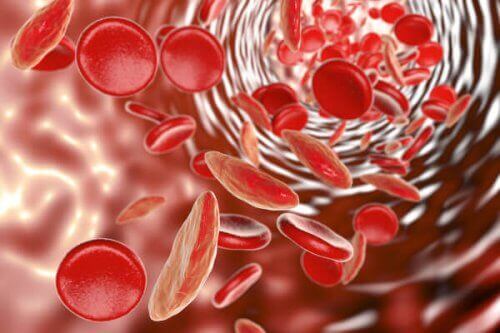Anemia in Adolescents: Symptoms and Treatment

Anemia is characterized, essentially, by the reduction of red blood cells in the body. Unfortunately, this is an illness that can affect children and adolescents. In fact, anemia in adolescents can be difficult to treat.
Adolescence is a stage of life that can be exhausting, in every sense. As a result, young people need plenty of nutrients and energy. This proactive state is very normal between 10 and 19 years old.
The connection between menstruation and anemia in adolescents
There are physical conditions that increase the probability of suffering from anemia. For example, young girls who lose a lot of blood during their periods are vulnerable. They’re prone to anemia from iron deficiency.
In these cases, frequent medical checkups are important. Ideally, menstruation shouldn’t affect girls’ quality of life, although on occasions it does. This problem can set off other effects on girls’ health and other areas of life, such as academic or social.
However, the presence of a heavy menstrual flow isn’t the only cause of anemia in adolescence. In fact, male teenagers can also suffer from anemia as a result of the loss of red blood cells.

Young people affected by fatigue from anemia
Lifestyle can also have a big influence. For example, young people who follow vegetarian diets often suffer from anemia. The problem comes from eliminating protein from meat from their diet. If this occurs, the best solution is to find substitute foods.
In the case of boys, this type of problem is much less common. For them, anemia is often part of the illnesses mentioned above.
“A young person who tires quickly and sleeps too much might be anemic.”
Anemia in adolescence: iron deficiency is key
The lack of red blood cells, or deficiency, along with low iron in the body, restricts the amount of oxygen that goes to each organ. In practice, iron is in charge of transporting oxygen to all the organs in the human body. This is why consuming iron supplements is a fundamental part of the treatment .
The good news is that this situation can be prevented. Diet and supplements are fundamental for normalizing your child’s life. As parents, you’ll need to know the symptoms to be on the alert.
Symptoms of anemia in adolescents
If an adolescent has very low energy, it may be time to act. A young person who tires easily and sleeps too much may be anemic.
Other symptoms include pale skin, irritability, loss of appetite, and constant repeated infections. Additionally, arrhythmia and changes in heartbeat can be a symptom of anemia.
Anemia in adolescence prevents affected teenagers from developing normally. To avoid risks, continue regular doctor’s visits, at least annually.

Treatments for anemia in adolescents
For adolescents affected by anemia, the best solution is to keep red blood cells from getting into poor condition. The recommended treatments almost always include the following:
- Supplemented diet: anemic patients should eat foods rich in iron. Meat, cereals, and grains are often rich in this mineral.
- Iron supplements: in many cases, it’s a good idea to buy iron supplements. Almost all types that are sold over the counter will work to supplement a healthy diet.
- Vitamin B also helps: consuming B complex vitamins and vitamins from that group is an ideal dietary supplement. Pills or liquids are both effective.
- Advanced anemia: if the case is more advanced, other measures will be taken. For example, blood transfusions can often help patients who have reached a crisis point. There are also medications to improve blood composition.
In practice, all treatments should be approved by a medical specialist, especially if the patient suffers other illnesses. Beyond that, a balanced diet supplemented with vitamins and minerals is always a good idea.
Anemia is characterized, essentially, by the reduction of red blood cells in the body. Unfortunately, this is an illness that can affect children and adolescents. In fact, anemia in adolescents can be difficult to treat.
Adolescence is a stage of life that can be exhausting, in every sense. As a result, young people need plenty of nutrients and energy. This proactive state is very normal between 10 and 19 years old.
The connection between menstruation and anemia in adolescents
There are physical conditions that increase the probability of suffering from anemia. For example, young girls who lose a lot of blood during their periods are vulnerable. They’re prone to anemia from iron deficiency.
In these cases, frequent medical checkups are important. Ideally, menstruation shouldn’t affect girls’ quality of life, although on occasions it does. This problem can set off other effects on girls’ health and other areas of life, such as academic or social.
However, the presence of a heavy menstrual flow isn’t the only cause of anemia in adolescence. In fact, male teenagers can also suffer from anemia as a result of the loss of red blood cells.

Young people affected by fatigue from anemia
Lifestyle can also have a big influence. For example, young people who follow vegetarian diets often suffer from anemia. The problem comes from eliminating protein from meat from their diet. If this occurs, the best solution is to find substitute foods.
In the case of boys, this type of problem is much less common. For them, anemia is often part of the illnesses mentioned above.
“A young person who tires quickly and sleeps too much might be anemic.”
Anemia in adolescence: iron deficiency is key
The lack of red blood cells, or deficiency, along with low iron in the body, restricts the amount of oxygen that goes to each organ. In practice, iron is in charge of transporting oxygen to all the organs in the human body. This is why consuming iron supplements is a fundamental part of the treatment .
The good news is that this situation can be prevented. Diet and supplements are fundamental for normalizing your child’s life. As parents, you’ll need to know the symptoms to be on the alert.
Symptoms of anemia in adolescents
If an adolescent has very low energy, it may be time to act. A young person who tires easily and sleeps too much may be anemic.
Other symptoms include pale skin, irritability, loss of appetite, and constant repeated infections. Additionally, arrhythmia and changes in heartbeat can be a symptom of anemia.
Anemia in adolescence prevents affected teenagers from developing normally. To avoid risks, continue regular doctor’s visits, at least annually.

Treatments for anemia in adolescents
For adolescents affected by anemia, the best solution is to keep red blood cells from getting into poor condition. The recommended treatments almost always include the following:
- Supplemented diet: anemic patients should eat foods rich in iron. Meat, cereals, and grains are often rich in this mineral.
- Iron supplements: in many cases, it’s a good idea to buy iron supplements. Almost all types that are sold over the counter will work to supplement a healthy diet.
- Vitamin B also helps: consuming B complex vitamins and vitamins from that group is an ideal dietary supplement. Pills or liquids are both effective.
- Advanced anemia: if the case is more advanced, other measures will be taken. For example, blood transfusions can often help patients who have reached a crisis point. There are also medications to improve blood composition.
In practice, all treatments should be approved by a medical specialist, especially if the patient suffers other illnesses. Beyond that, a balanced diet supplemented with vitamins and minerals is always a good idea.
All cited sources were thoroughly reviewed by our team to ensure their quality, reliability, currency, and validity. The bibliography of this article was considered reliable and of academic or scientific accuracy.
- Guía breve sobre la anemia. National Institutes of Health.
- World Health Organization. Iron deficiency anaemia assessment, prevention and control. A guide for programme managers. Geneva, Switzerland. World Health Organization 2001.
- Garanito Marlene P., Pitta Tassiana S., Carneiro Jorge David A.. Deficiência de ferro na adolescência. Rev. Bras. Hematol. Hemoter. [Internet]. 2010; 32 (2): 45-48. http://dx.doi.org/10.1590/S1516-84842010005000056
This text is provided for informational purposes only and does not replace consultation with a professional. If in doubt, consult your specialist.








